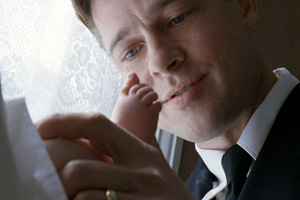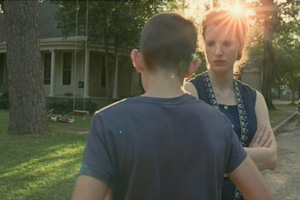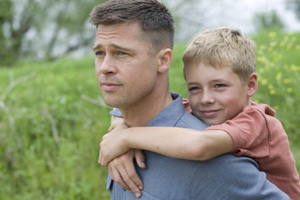THE TREE OF LIFE: Film Print vs. Digital Print
(The Tree of Life is now available on DVD and 3-Disc Blu-ray/DVD Combo + Digital Copy.)
 The Landmark Sunshine is showing The Tree of Life in several theaters. On their biggest screen (theater #1) it plays digitally; in one of the smaller theaters upstairs (#5) it plays on a film print. There are noticeable differences between the two and I urge you to see it twice: once on film and once digitally.
The Landmark Sunshine is showing The Tree of Life in several theaters. On their biggest screen (theater #1) it plays digitally; in one of the smaller theaters upstairs (#5) it plays on a film print. There are noticeable differences between the two and I urge you to see it twice: once on film and once digitally.
For my money, it is the IMAX/space/planets/abstract sequence that most benefits from the lower contrast film print. Digitally those sequences—the weakest part of the film overall—popped so boldly that it took me out of a domestic drama and into a science film playing in a planetarium. On film, the red lava oozing out of the black rock has a rich, deep presence, while digitally, it just reads as red on black. In the dinosaur sequence, the film print’s lower contrast and softer focus makes the final wide shot image of the dinosaur walking into the sun way more bearable. On the digital print you are aware of the way the creature is rendered and you’re looking at the water ripples as its feet lift and land.
 On the film print, the white blown out sky is more milky blue than solid white. The result of this is that the foreground material, whether it’s a green branch or a face, seems to have more distinct weight and presence in the film print due to how differently it sits against the milky sky. Digitally, everything is in equally sharp focus and the lines between the white sky and the edge of the faces are so sharp and contrasty that you are overwhelmed by information. In the film print you feel the color in the grass, the shades of blush on the faces, the late afternoon long shadows in the hallway and on the porch. The film print is also way more conducive to showing the fair skinned mother’s translucent skin. On film her skin tone conveys an aura and a presence that is merely indicated on the digital print. Overall, I’d say the film print makes all the skin tones warmer. Digitally, the gradations in light are so distinctly rendered over the expanse of wide shots that you are actually distracted by all the information. For example, in a later shot the camera rises up through the branches of the tree above the backyard; digitally, the detail in the bark of the tree is so sharp I thought it was a composite shot because of its contrast against the grass below. In the film print I was not distracted by foreground detail and I felt myself more emotionally connected to the shot as we lifted away from childhood.
On the film print, the white blown out sky is more milky blue than solid white. The result of this is that the foreground material, whether it’s a green branch or a face, seems to have more distinct weight and presence in the film print due to how differently it sits against the milky sky. Digitally, everything is in equally sharp focus and the lines between the white sky and the edge of the faces are so sharp and contrasty that you are overwhelmed by information. In the film print you feel the color in the grass, the shades of blush on the faces, the late afternoon long shadows in the hallway and on the porch. The film print is also way more conducive to showing the fair skinned mother’s translucent skin. On film her skin tone conveys an aura and a presence that is merely indicated on the digital print. Overall, I’d say the film print makes all the skin tones warmer. Digitally, the gradations in light are so distinctly rendered over the expanse of wide shots that you are actually distracted by all the information. For example, in a later shot the camera rises up through the branches of the tree above the backyard; digitally, the detail in the bark of the tree is so sharp I thought it was a composite shot because of its contrast against the grass below. In the film print I was not distracted by foreground detail and I felt myself more emotionally connected to the shot as we lifted away from childhood.
 As for the film as a whole, there is nothing complicated or even oblique about its narrative. In fact, my main problem is with its simplistic reliance on the Christian narrative as a means to embrace “meaning.” However, I do find it extremely depressing that there are critics like Richard Schickel who don’t ‘get it.’ I can forgive the inexperienced viewer ‘s frustrations with the film because they have only been exposed to film narrative that is plot based and reliant on simplistic cause and effect action/reaction, but when a critic who has seen all kinds of film is resistant, that is sad. That said, the film does have lots of problems. The overly long space and IMAX imagery is the biggest misfire, but the other problem is Malick’s cowardly reliance on the simpleminded Christian myth. I wish he could have found his own meaning rather than just cribbing from the biggest copout myth ever that “we’ll all come together later in heaven.” Still, the image of the older son, played by Sean Penn, embracing his younger father and mother on the beach was extremely powerful, despite its easy Christian “meaning.”
As for the film as a whole, there is nothing complicated or even oblique about its narrative. In fact, my main problem is with its simplistic reliance on the Christian narrative as a means to embrace “meaning.” However, I do find it extremely depressing that there are critics like Richard Schickel who don’t ‘get it.’ I can forgive the inexperienced viewer ‘s frustrations with the film because they have only been exposed to film narrative that is plot based and reliant on simplistic cause and effect action/reaction, but when a critic who has seen all kinds of film is resistant, that is sad. That said, the film does have lots of problems. The overly long space and IMAX imagery is the biggest misfire, but the other problem is Malick’s cowardly reliance on the simpleminded Christian myth. I wish he could have found his own meaning rather than just cribbing from the biggest copout myth ever that “we’ll all come together later in heaven.” Still, the image of the older son, played by Sean Penn, embracing his younger father and mother on the beach was extremely powerful, despite its easy Christian “meaning.”
 Despite the forced ending and the cheesy IMAX planetarium sequences, you cannot argue with the brute visual force of the father/son family drama. As for its meaning, what I tell people is, have you ever returned to your old family home, years after you moved out, or years after your parents died? Did you ever walk those empty rooms and wonder where the memories went? Where did the time go? Where did that young you go? Did you ever return to the backyard, like Robert Mitchum in The Lusty Men and dig up the toys you buried when you were a child? Those rush of memories and that vague slightly confusing sense of time passed is what The Tree of Life is about, and it is rendered physical through the pure technical brilliance of a filmmaker at the top of his game. The film for me most resembles Su Friedrich’s Sink or Swim. It really has way more in common with many American non-narrative masterpieces, way more than any other more plot driven film. It’s really closer to a combination of Sink or Swim with Terrence Davies’ Distant Voices, Still Lives, mixed with late Kenneth Anger myth films like Lucifer Rising.
Despite the forced ending and the cheesy IMAX planetarium sequences, you cannot argue with the brute visual force of the father/son family drama. As for its meaning, what I tell people is, have you ever returned to your old family home, years after you moved out, or years after your parents died? Did you ever walk those empty rooms and wonder where the memories went? Where did the time go? Where did that young you go? Did you ever return to the backyard, like Robert Mitchum in The Lusty Men and dig up the toys you buried when you were a child? Those rush of memories and that vague slightly confusing sense of time passed is what The Tree of Life is about, and it is rendered physical through the pure technical brilliance of a filmmaker at the top of his game. The film for me most resembles Su Friedrich’s Sink or Swim. It really has way more in common with many American non-narrative masterpieces, way more than any other more plot driven film. It’s really closer to a combination of Sink or Swim with Terrence Davies’ Distant Voices, Still Lives, mixed with late Kenneth Anger myth films like Lucifer Rising.
The Tree of Life is an American masterwork, despite its simplistic, cowardly embrace of Christian meaning as an answer to the inciting incident /question: “How do we justify the death of a child? What meaning is there in death and loss?” The easy answers offered still don’t negate the fact that the film renders the quite specific dynamic between a father/son and family in a physical visual manner that is, quite simply, pure cinema.
— Mike S. Ryan












adamhump
you seem confused
Hunter
Calling the embrace of Christian meaning “cowardly” doesn’t seem like a valid criticism. Terrence Malick is an Episcopalian, and that outlook is naturally going to inform his storytelling in the way he explores themes. Asking him to do otherwise is asking him to be dishonest as an artist.
Walt
I appreciate the Film Print/Digital comparison, but I don’t know why you think we care about your personal reaction to the film.
unread_writer
“Cowardly” may not be quite the right word, but there’s nothing amiss in Mike Ryan pointing out that taking refuge in the supernatural, whether that means a superhero or Christian myth, hasn’t been a defensible narrative development in adult art for several hundred years now, whatever the beliefs of the writer or his audience may be.
The more common strategy today, for writers who run out of ideas, is magico-mystical mumbo-jumbo, as seen as network TV. Which makes about as sense as heaven as a resolving device.
Kyle Crockard
It doesn’t sound like there’s really a reason to see it a second time on digital if it’s so distracting and far too sharp – the recommendation here is to get into a film theatre to check it out. I will!
Jonathan Houting
The title of this piece is quite misleading. I’ve counted 36 sentences in the article, only 16 of which actually pertained to how the digital print was different from the film print. While this part was actually interesting, I had no desire to read another review of the film, especially one that is so glib, one-sided and doesn’t actually have a conversation with the film. Better try next time.
Jonathan Houting
The title of this article is very misleading. I counted 36 sentences in the piece, only 16 of which actually pertain to how the film print differs from the digital print. While this was interesting (although I don’t know how many people would be able to tell the difference if they didn’t know which one they were going to see the movie with), I didn’t want to read another review of the movie, especially one that is so glib and doesn’t really have a conversation with the film. Better try next time.
Lyncho14
I loved TREE OF LIFE and I did love the space IMAX imagery I felt that added to the themes of chaos, life and creation. Showing how vast the universe is and that it shows contrast between the tensions that were happening in the film. I saw this film weeks ago, but I remember feeling that there was some irony from the scene before we enter the Space sequence. It brought me back to Space Oddy 2001 feelings. Which is another reason this film is a must see on the big screen on a 35mm print.
I think overall Terrance Mailk’s ability to be a visual story teller and make you feel like you are watching real life but yet it’s photographed with such beauty. I love his work.
Grant
One very simple aspect of the film to digital argument I would recommend you include is the aspect of reel changes on a physical print. My initial viewing at an advance screening was digital and my second viewing upon release in 35mm. Having worked as a projectionist for many years growing up and now as a hobby/side job, a reel change is embedded in my mind from many years of screening prints before release to check their quality. With the digital presentation of The Tree of Life, I felt a greater sense of immersion into the film with no reel changes. A sign of a really good film for me over the years has become when I do not notice reel changes.
cheetah
I get the sense that Mike S. Ryan made up his mind that Tree Of Life was a masterpiece before he even saw it. Like Nick Pinkerton at Village Voice who said Tree Of Life was beyond a masterpiece.
The father/son drama is half the movie. If Ryan is saying that is what the movie is about or that is the masterful aspect of the movie, um, that leaves out half the movie as not masterful.
But these people heard Malick was making a movie about the universe and that was it. That was all they needed. Tree Of Life is probably Malick’s most flawed film. Not as epic as Thin Red Line. Not as original as Badlands as that is where Malick first did his poetic dance. But these guys like Ryan and Pinkerton made up their mind when they first heard about the movie.
Carlos
Came here looking for information about whether I should see the film digitally or on film…. having not yet seen the film, i wasn’t coming hoping for spoilers. Would be nice if there was a tl;dr for people who plan to only see the film once to make a choice.
Tom Whelan
Thanks, Mike, for the thoughtful digital/film print comparison. In film school, back in 1987, we were told film would be dead and digital would take over “in ten years.” We are not there yet.
Anonymous
You’re retarded.